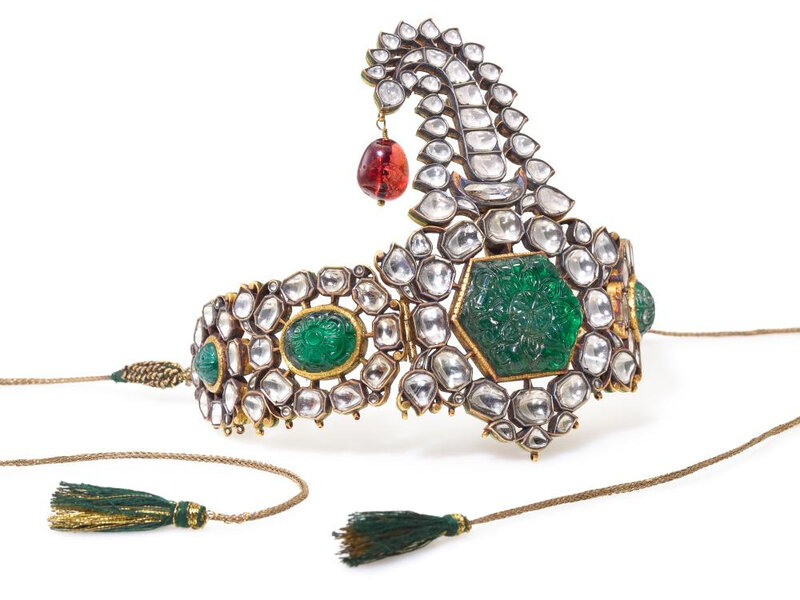An important gem-set and enamelled turban ornament (sarpech), India, probably Deccan, 19th century



Lot 171. An important gem-set and enamelled turban ornament (sarpech), India, probably Deccan, 19th century. Estimate 120,000 — 180,000 GBP (139,296 - 208,944 EUR). Lot sold 350,000 GBP. Courtesy Sotheby's.
the openwork hinged body set with foiled diamonds and a large central octagonal carved emerald between four smaller carved emeralds, topped with a curling jigha and hanging spinel, the reverse with polychrome enamelled floral details and birds, compartment for jigha, suspension cords; 11.2cm. height, 20cm. diam.
Provenance: Family of Hari Singh Nalwa (1791-1837), by descent.

General Hari Singh Nalwa with Maharaja Ranjit Singh and Bishan Singh © photo courtesy of Toor Collection
Note: Only the Mughal emperor, his intimate relations and select members of his entourage were permitted to wear a royal turban ornament (Prior and Adamson 2000, pp.38-39).
In the period of Emperor Akbar’s reign (1556-1605), the principal turban ornament was the kalgi, a simple gold or jewelled stem into which a heron feather was inserted (ibid, pp.38-39). During the reign of Shah Jahan, an ornate jewelled brooch appears to have taken the place of the feather. This solid plume retained the characteristic droop of the Jahangiri feather kalgi and one or more pendant stones were added to it as ornaments. In this form, the turban ornament is known as a jigha, though it is important to note that like the present example, most jighas retain a stem or tana for the insertion of the original feathered plume.
Retaining their imperial connotations, such kalgis were considered as marks of honour, worn by the emperor and ceremonially presented on important occasions. These continued to hold their mark of prestige as notable examples entered into British aristocratic collections. One is in the collection of Robert, 1st Lord Clive; 'Clive of India' (illustrated in Prior and Adamson, p.67) and another example now in the Victoria and Albert Museum (inv. no IS.3&A-1982) was originally presented to Admiral Charles Watson on 26 July 1757 by Mir Ja’far ‘Ali Khan, successor to Suraj-ud-Daula as the Nawab of Bengal.
Sotheby's. Arts of the Islamic World including Fine Rugs and Carpets, London, 01 May 2019, 10:30 AM

/https%3A%2F%2Fprofilepics.canalblog.com%2Fprofilepics%2F1%2F0%2F100183.jpg)
/https%3A%2F%2Fstorage.canalblog.com%2F03%2F02%2F119589%2F96711876_o.jpg)
/https%3A%2F%2Fstorage.canalblog.com%2F11%2F31%2F119589%2F94773502_o.jpg)
/https%3A%2F%2Fstorage.canalblog.com%2F20%2F83%2F119589%2F94772815_o.jpg)
/https%3A%2F%2Fstorage.canalblog.com%2F26%2F72%2F119589%2F75604929_o.jpg)
/https%3A%2F%2Fstorage.canalblog.com%2F59%2F60%2F119589%2F26458628_o.jpg)


/http%3A%2F%2Fstorage.canalblog.com%2F00%2F00%2F119589%2F129758935_o.jpg)
/http%3A%2F%2Fstorage.canalblog.com%2F29%2F28%2F119589%2F129637299_o.jpg)
/http%3A%2F%2Fstorage.canalblog.com%2F88%2F37%2F119589%2F129631480_o.jpg)
/http%3A%2F%2Fstorage.canalblog.com%2F77%2F79%2F119589%2F129631259_o.jpg)